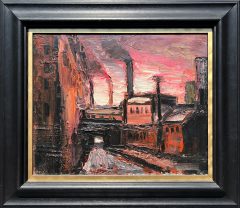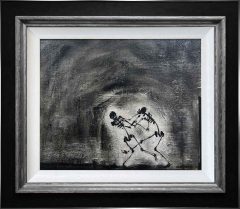Theodore Major (1908 - 99)
Showing all 2 results
Theodore Major (1908 – 99)
Theodore Major was born in Wigan, and is considered as Britain’s last forgotten twentieth-century master.
In 1958, John Berger wrote in the New Statesman, claiming that Major’s ‘best canvases… Deserve to hang among the best English paintings of our time, alongside the early Spencers and the best Hermans…’ And yet Major eschewed the siren call of critical and financial success – indeed, throughout his life he remained aloof from the commercial side of his profession. He was always reluctant to sell his paintings, and when he did, he made it as difficult as possible for any such transaction to be successfully completed.
Galleries
Many galleries wooed him with little or no success, to such an extent that he rejected out-of-hand Lowry’s invitation to share his association with the prestigious Lefevre Gallery in London. Why? Because Major lived a life completely dedicated to Art (a word he always spelt it with a capital ‘A’). He modelled both his life and his art on the example of a few – very few – chosen mentors: Michelangelo, Rembrandt, William Blake and Van Gogh. Artists whose work was underpinned by its evangelical purpose.
His conviction in this belief was such that he would send curators and collectors away from his house, often telling them to call on Mr Lowry instead. As a result, Major is neither widely known nor well-represented in public collections. The work that is publicly available represents only a very narrow aspect of his extraordinary and utterly compelling art.
Born in 1908, Major’s mature art was fired by memories of his early childhood. He remembered ‘the dark streets, the red flames of open blast furnaces on wet pavements. I saw my playmates walking on fire. Seeing the morning mists, the light of yellow sun, the dark clouds, the pattern of smoke against grey sky. I saw the white sailing moon. Seeing the dignity of workmen and the beauty and warmth of women. I saw God in every child.’
Poetry
Such statements reveal his abiding love for the poetry and art of William Blake. (to whom he bore an astonishing physical resemblance) and, of course, the paintings of Van Gogh. Art that embraces every aspect of life from the most apparently trivial to the most sublime – there is no evidence of packaged sentimentality or soft-focus nostalgia in such art.
Major was a born teacher and a great communicator with a tremendous gift for a telling turn of phrase:
‘I don’t paint pictures for people to live with – my paintings are not created to decorate a room. How would these people like to live with Michelangelo’s Sistine Chapel paintings? I always get mentioned with L. S. Lowry – why? I feel and express the opposite to Lowry. He expressed his own sadness and loneliness. I try to express nothing of myself – but the thing I am painting… I feel much in common with Blake, Picasso, Van Gogh and all the great masters of painting, music and poetry. These are my real friends…’
Lowry
Comparisons with the work of Lowry infuriated him – they were friends, they respected each other, and in fact. Lowry thought Theo the better painter. Theo was rooted spiritually and physically in the environs of Wigan. Much as he admired Lowry, Lowry’s association with the London art market meant that they would never be close friends. Theo saw Lowry’s work as perpetuating an image of the north that undermined the reality of the Wigan landscape and its people – their suffering and humanity. For the same reason, he attacked George Orwell’s representation of Wigan in his famous 1930s work, The Road to Wigan Pier.
Theodore Major followed no political agenda, but railed like some Old Testament prophet against the madness of his times – hence his atom bomb paintings, and, at the end of his life, apocalyptic paintings of skeletons and, most extraordinary of all, terrifying monsters.
This would be as nothing if his work itself were not so powerful. Major’s oeuvre is characterised by a complete disregard for any notion of ‘good taste’. His work, which is various and wide-ranging in subject and technique has to be seen in the original.
Technique
He painted intuitively, building up layers of magnificent and unexpected currents of colour, which are then scraped down and reworked as necessary to create paintings of a tapestry-like density. He was both a brilliant colourist and, at the other extreme, a painter who could manage the most subtle shifts of monochrome, from the darkest of darks to the purest of whites and all the silvery tones between.
Major died in 1999, deeply loved and respected by all who knew him. He remained a rebel to the end, still refusing to sell his work, except when money was needed to buy painting materials. It is time for his paintings to find the wider audience they truly deserve – they have much to teach us.
Masterplan
The first floor of Haigh Hall will be dedicated to culture and heritage, with an exhibition of Theodore Major’s work, who rarely put his artwork on display.




